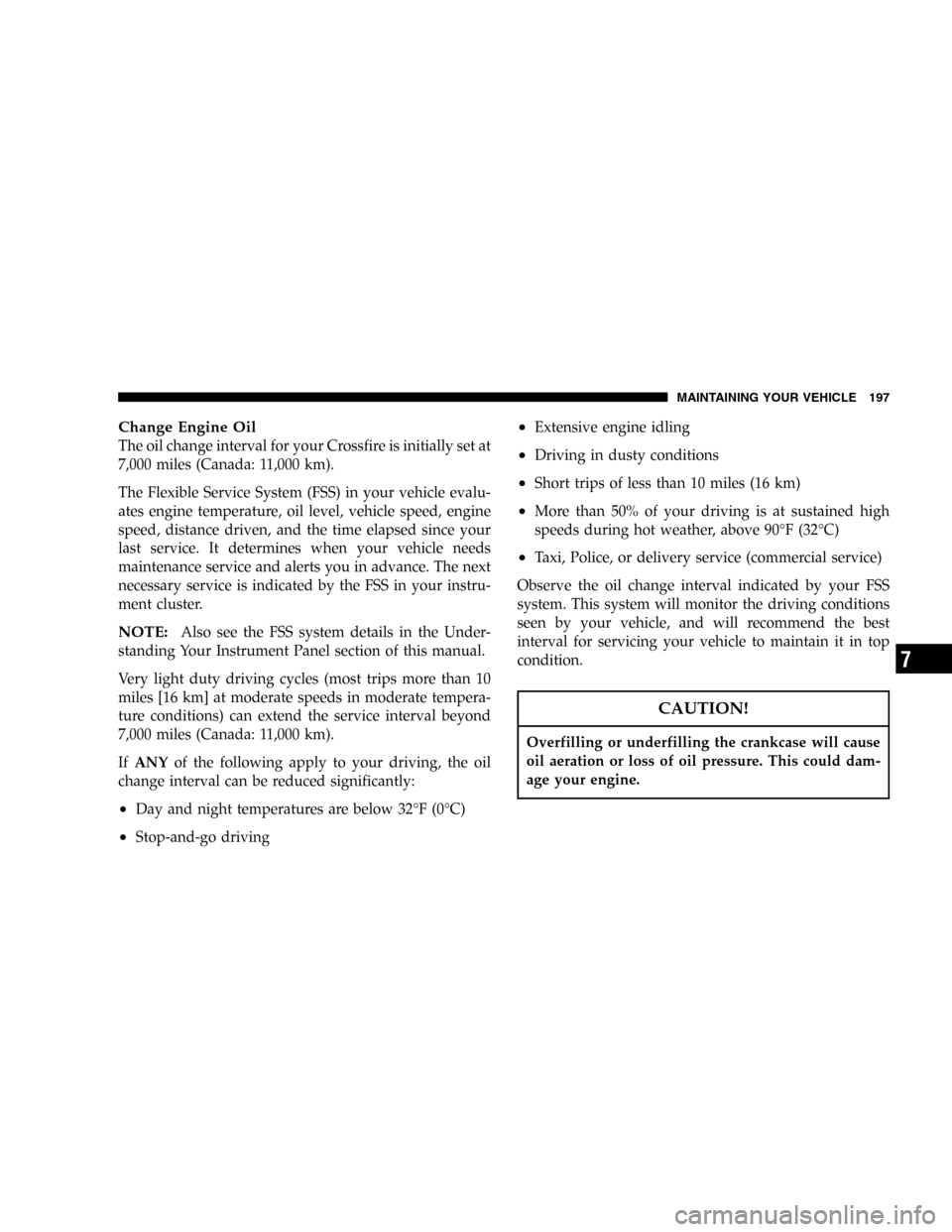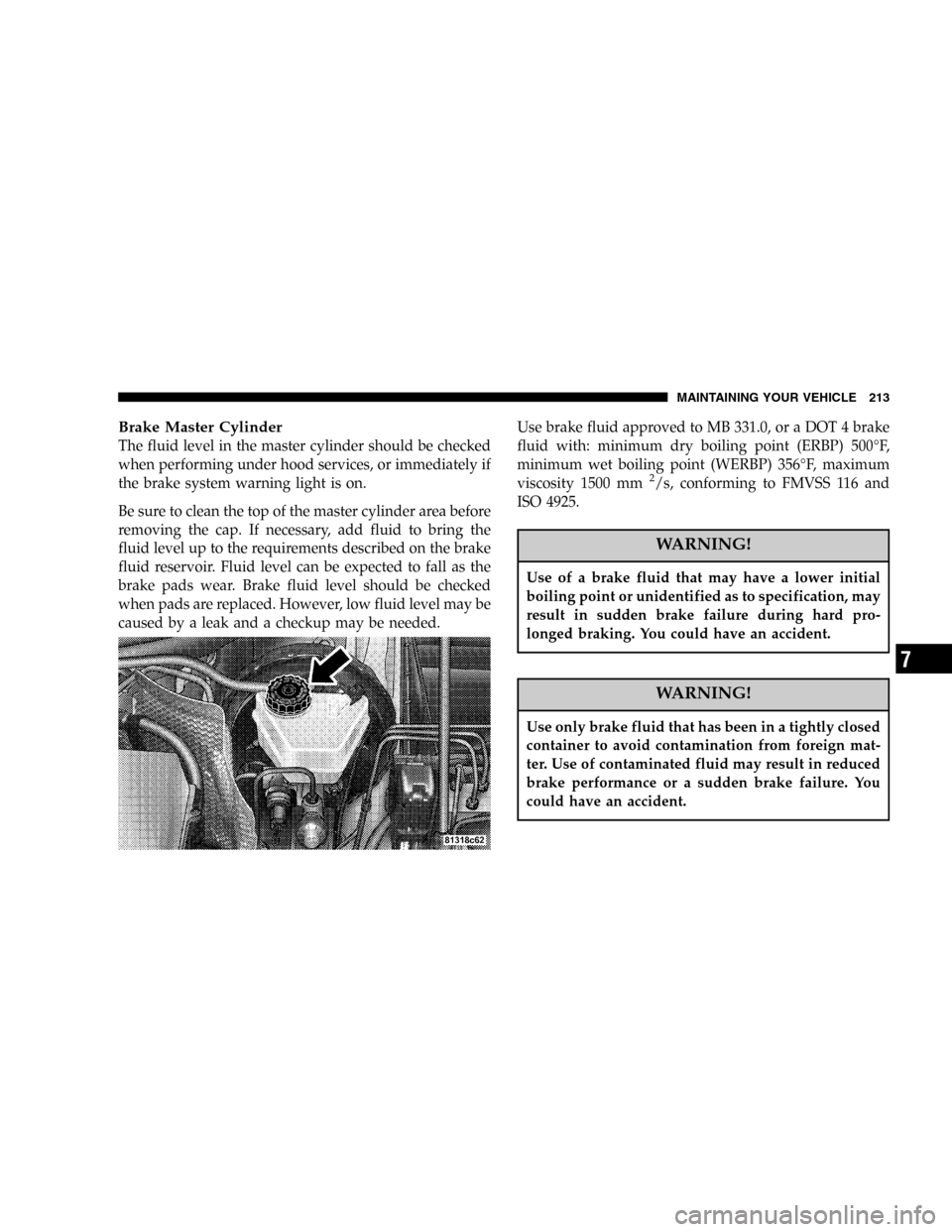Page 46 of 280

WARNING!
An incorrectly anchored tether strap could lead to
increased head motion and possible injury to the
child. Use only the anchor position directly behind
the child seat to secure a child restraint top tether
strap.
Transporting Pets
Deploying airbags could harm your pet. An unrestrained
pet will be thrown about and possibly injured, or injure a
passenger during panic braking or in a collision.
Pets should be restrained in pet harnesses or pet carriers
that are secured by seat belts.
ENGINE BREAK-IN RECOMMENDATIONS
The engine in your new Crossfire does not require a long
break-in period. Following these few simple guidelines is
all that is necessary for a good break-in.
•Drive your vehicle at moderate vehicle and engine
speeds during the first 1,000 miles (1,600 km).
•Do not make any full throttle starts and avoid full
throttle acceleration.
•Use the proper transmission gear for your speed
range.
•Avoid excessive idling.
•Check the engine oil level at every fuel fill.
NOTE:A new engine may consume some oil during the
first few thousand miles of operation. This should be
considered as a normal part of the break-in and not an
indication of a problem.
46 THINGS TO KNOW BEFORE STARTING YOUR VEHICLE
Page 109 of 280

If the Check Engine light remains on continuously and
the vehicle is driving normally, you may still drive the
vehicle. In most situations, the vehicle will not require
towing. However, we recommend that you have the
system checked at an authorized dealer as soon as
possible.
If the vehicle is not driving normally, and the Check
Engine light flashes or remains on continuously, it is an
alert to serious conditions that could lead to loss of power
or severe catalytic converter damage. The vehicle should
be serviced at an authorized dealer as soon as possible.
27. Brake Wear Indicator Light
With the key in the ignition and turned to the
ON/RUN position, the brake wear indicator
light comes on. The light goes out when the
engine is running.
If the indicator light comes on during braking, this
indicates the brake pads are worn down.
Have the brake system checked at your authorized dealer
as soon as possible.
28. Oil Level Indicator Light
With the key in the ignition switch turned to
the ON/RUN position, the oil level indicator
light comes on. It should go out immediately
when the engine is running. If the light does
not go out, or comes on while driving, the engine oil
level has dropped to approximately the minimum
mark on the dipstick.
CHECKING ENGINE OIL LEVEL
A sensor in the oil pan allows oil level to be checked
without opening the hood. It provides an accurate mea-
surement of oil level, whereas the low engine oil level
indicator warns that oil level is definitely too low. With
the vehicle parked on a level surface, the engine is
warmed up and shut off for approximately five minutes.
When the ignition switch is turned to the ON/RUN
position, an ISO oil level icon appears in the trip odom-
eter window and a“clock”icon in the cumulative
odometer display. Pressing the knob to the left of the
speedometer twice within one second displays one of the
following messages:
UNDERSTANDING YOUR INSTRUMENT PANEL 109
4
Page 110 of 280

•OK
•-1.0 Q (-1.0L)
•-1.5 Q (-1.5L)
•-2.0 Q (-2.0L)
•HI
The indicated amount of oil must be added to the engine
if the message -2.0 Q (-2.0L) blinks and a signal sounds.
The HI message indicates that the excess oil must be
removed from the pan to avoid possible engine or
catalytic converter damage. If the ISO oil level icon and
“clock”icon remain on when attempting to check oil
level and no message follows, or if the low engine oil
level warning lamp comes on, a malfunction in the
engine oil level system is indicated. A conveniently
located dipstick allows manual checking of the oil level.If no leaks are noted, continue to drive to the nearest
service station where the engine oil should be topped to
the“full”mark on the dipstick with an approved oil.
29. Low Fuel Warning Light
When the fuel level drops to about 2 gallons (7.5
liters), this symbol will light and remains lit until
fuel is added.
“INFINITY MODULUS” AM/FM STEREO RADIO
WITH SINGLE-DISC CD PLAYER AND GPS
NAVIGATION
(OPTIONAL - See separate User’s Manual)
110 UNDERSTANDING YOUR INSTRUMENT PANEL
Page 195 of 280

WARNING!
You can be badly injured working on or around a
motor vehicle. Do only that service work for which
you have the knowledge and the proper equipment.
If you have any doubt about your ability to perform
a service job, take your vehicle to a competent
technician.
MAINTENANCE PROCEDURES
The pages that follow contain the maintenance service
recommended by the engineers who designed your ve-
hicle.
Besides the maintenance items for which there are fixed
maintenance intervals, there are other items that should
operate satisfactorily without periodic maintenance.
However, if a malfunction of these items does occur, it
could adversely affect the engine or vehicle performance.
These items should be inspected if a malfunction is
observed or suspected.
Engine Oil
Checking Oil Level
To assure proper engine lubrication, the engine oil must
be maintained at the correct level. Check the oil level at
regular intervals, such as every fuel stop.
You can check the oil level using the procedure described
in Checking Engine Oil Level in the Understanding Your
Instrument Panel section, or by checking the engine oil
dipstick.
MAINTAINING YOUR VEHICLE 195
7
Page 196 of 280
The best time to check the engine oil level is about 5
minutes after a fully warmed engine is shut off, or before
starting the engine after it has sat overnight.
Checking the oil while the vehicle is on level ground will
improve the accuracy of the oil level readings. Maintain
the oil level between the MIN and MAX markings on the
dipstick. Adding one quart of oil when the reading is at
the MIN mark will result in a MAX reading on this
engine.
196 MAINTAINING YOUR VEHICLE
Page 197 of 280

Change Engine Oil
The oil change interval for your Crossfire is initially set at
7,000 miles (Canada: 11,000 km).
The Flexible Service System (FSS) in your vehicle evalu-
ates engine temperature, oil level, vehicle speed, engine
speed, distance driven, and the time elapsed since your
last service. It determines when your vehicle needs
maintenance service and alerts you in advance. The next
necessary service is indicated by the FSS in your instru-
ment cluster.
NOTE:Also see the FSS system details in the Under-
standing Your Instrument Panel section of this manual.
Very light duty driving cycles (most trips more than 10
miles [16 km] at moderate speeds in moderate tempera-
ture conditions) can extend the service interval beyond
7,000 miles (Canada: 11,000 km).
IfANYof the following apply to your driving, the oil
change interval can be reduced significantly:
•Day and night temperatures are below 32°F(0°C)
•Stop-and-go driving
•Extensive engine idling
•Driving in dusty conditions
•Short trips of less than 10 miles (16 km)
•More than 50% of your driving is at sustained high
speeds during hot weather, above 90°F (32°C)
•Taxi, Police, or delivery service (commercial service)
Observe the oil change interval indicated by your FSS
system. This system will monitor the driving conditions
seen by your vehicle, and will recommend the best
interval for servicing your vehicle to maintain it in top
condition.
CAUTION!
Overfilling or underfilling the crankcase will cause
oil aeration or loss of oil pressure. This could dam-
age your engine.
MAINTAINING YOUR VEHICLE 197
7
Page 213 of 280

Brake Master Cylinder
The fluid level in the master cylinder should be checked
when performing under hood services, or immediately if
the brake system warning light is on.
Be sure to clean the top of the master cylinder area before
removing the cap. If necessary, add fluid to bring the
fluid level up to the requirements described on the brake
fluid reservoir. Fluid level can be expected to fall as the
brake pads wear. Brake fluid level should be checked
when pads are replaced. However, low fluid level may be
caused by a leak and a checkup may be needed.Use brake fluid approved to MB 331.0, or a DOT 4 brake
fluid with: minimum dry boiling point (ERBP) 500°F,
minimum wet boiling point (WERBP) 356°F, maximum
viscosity 1500 mm
2/s, conforming to FMVSS 116 and
ISO 4925.
WARNING!
Use of a brake fluid that may have a lower initial
boiling point or unidentified as to specification, may
result in sudden brake failure during hard pro-
longed braking. You could have an accident.
WARNING!
Use only brake fluid that has been in a tightly closed
container to avoid contamination from foreign mat-
ter. Use of contaminated fluid may result in reduced
brake performance or a sudden brake failure. You
could have an accident.
MAINTAINING YOUR VEHICLE 213
7
Page 235 of 280
FLUID CAPACITIES
Metric U.S.
Fuel (Approximate)60.0 Liters 15.8 Gallons
Fuel Tank Reserve8.0 Liters 2.1 Gallons
Engine Oil (with filter)
3.2 L Supercharged Engine 8.0 Liters 8.5 Qts.
Cooling System *
3.2 L Supercharged Engine 14.5 Liters 15.3 Qts.
Automatic Transmission8.0 Liters 8.5 Qts.
Rear Axle1.3 Liters 1.4 Qts.
Power Steering Reservoir1.0 Liters 1.1 Qts.
Brake Reservoir.5 Liters .5 Qts.
Windshield Washer Reservoir7.0 Liters 7.4 Qts.
* Includes heater and coolant recovery bottle filled to MAX level.
MAINTAINING YOUR VEHICLE 235
7